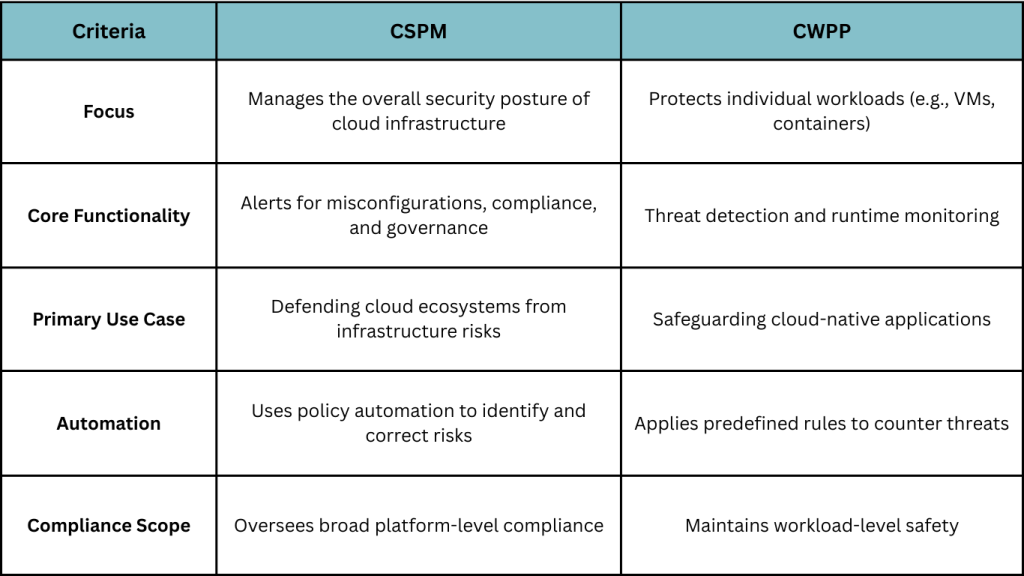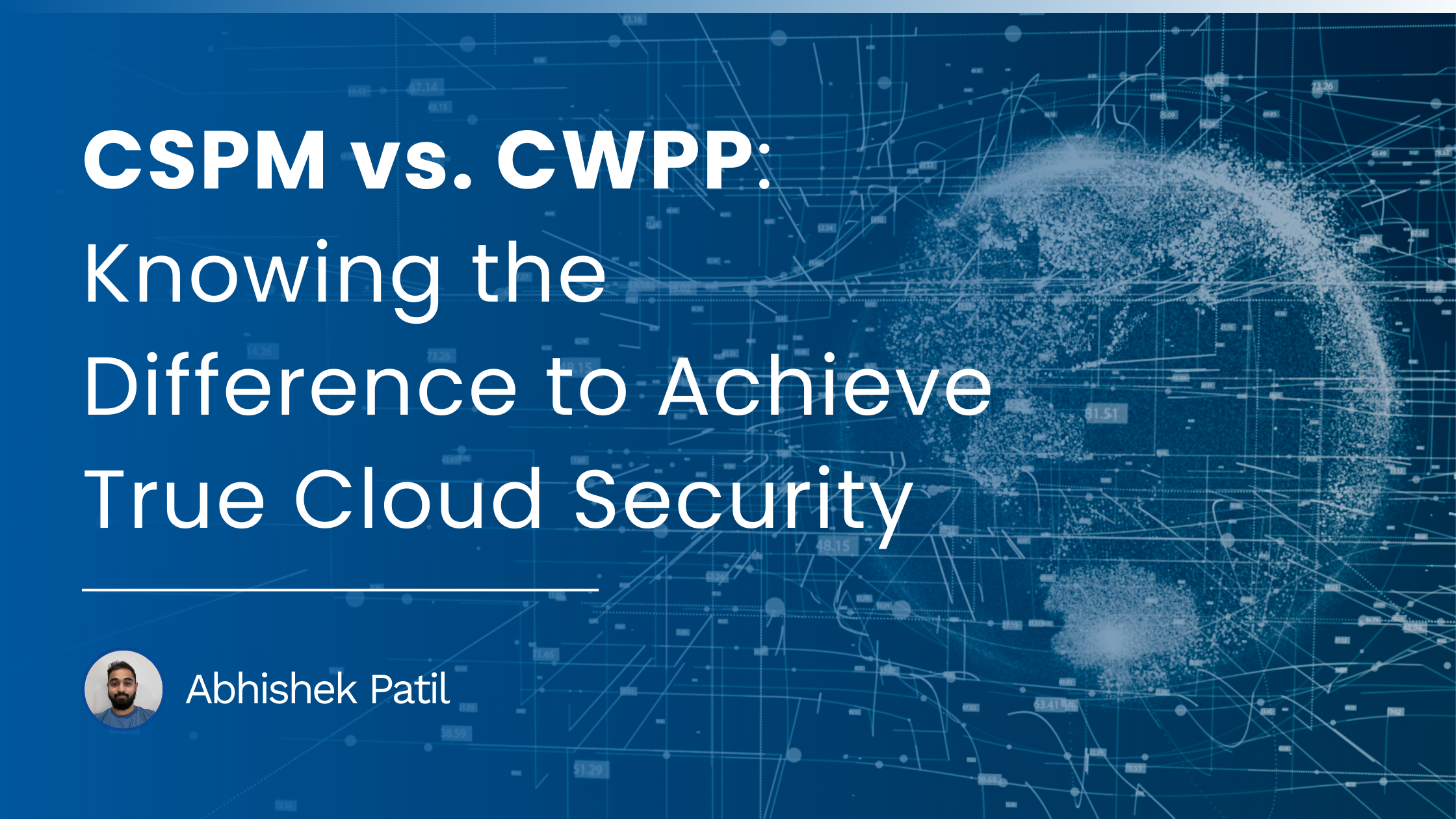For a business to achieve its full potential in the current digital-first era, they need to know the difference between CSPM vs. CWPP before adopting a cloud- or hybrid-based operational workflow. However, the threats posed by expanding attack surfaces in multicloud and hybrid architectures, traditional security approaches are falling short. Two leading technologies, Cloud Workload Protection Platforms (CWPP) and Cloud Security Posture Management (CSPM), have emerged as important components in modern cloud defense. When employed together, they offer a blueprint to help security professionals better protect cloud infrastructures from vulnerabilities, misconfigurations, and a host of other evolving cloud-based cyber threats.
What sets CWPP and CSPM apart? How do their unique capabilities contribute to a well-rounded cloud security strategy? This blog discusses their definitions, features, and use cases, compares their differences, and explains how they can work together to deliver a powerful defense against complex cyber risks. Finally, see how Saner Cloud integrates these solutions into an innovative, unified platform that raises the standard for cloud protection.
What is CSPM?
CSPM solutions address the overall security posture of cloud infrastructure rather than focusing on individual workloads. They monitor, detect, and correct configuration errors, governance gaps, or misaligned policies across the cloud ecosystem. This approach is key for maintaining sound cloud governance and compliance.
Why is CSPM Important?
Misconfigured cloud environments are frequent targets for cyber attackers. Vulnerabilities like misconfigured access controls, unencrypted data repositories, and insecure APIs fall under CSPM’s scope. With comprehensive visibility across all cloud assets, CSPM offers a scalable method for mitigating these risks and enhancing the security posture.
For example, a healthcare organization storing sensitive patient records in the cloud must comply with regulations such as HIPAA. CSPM simplifies compliance by proactively detecting and rectifying issues like open storage buckets or missing encryption layers.
What are the Characteristics of CSPM?
CSPM’s strength lies in monitoring the overall cloud framework through continuous vigilance. A few characteristics that are unique to CSPM are listed below.
- Proactive Risk Management: Automates the identification and removal of vulnerabilities to maintain a safe infrastructure.
- Unified Multicloud Visibility: Aggregates data from platforms like AWS, Azure, and Google Cloud to offer a consistent overview.
- Enhanced Governance: Aligns security operations with organizational policies and compliance mandates.
Core Capabilities of CSPM
Organizations benefit from several CSPM functions:
- Continuous Cloud Monitoring: Regular reviews of cloud environments confirm that configurations match approved security practices.
- Instant Risk Detection: The platform flags issues such as unprotected credentials, open ports, and poorly managed access controls before they are exploited.
- Compliance Automation: Facilitates adherence to frameworks like CIS, NIST, or ISO without extensive manual oversight.
- Cross-Platform Integration: Manages risks across multiple cloud providers, supporting a simplified and consistent security strategy.
Use Cases for CSPM
- Financial Institutions: Automate compliance with stringent regulations while defending sensitive customer data.
- Software Developers: Build and deploy applications within secure architectures to reduce vulnerabilities at launch.
What is CWPP?
CWPP refers to a solution designed to secure workloads in cloud-based environments. These workloads include containers, virtual machines (VMs), serverless functions, and any application running on public, private, or hybrid infrastructures. CWPP methods typically focus on identifying and neutralizing runtime threats, analyzing vulnerabilities, and maintaining cloud workload safety while meeting industry standards.
Why is CWPP Important?
Modern businesses increasingly operate across hybrid and multicloud architectures for flexibility and efficiency. Such operations introduce significant complexity in workload management and security. CWPP is a cloud-native solution built to address these challenges. The platform adapts to the dynamic nature of cloud environments by providing deep visibility into workloads and offering runtime protection that reduces the attack surface.
For example, consider an organization running customer-facing applications on AWS while using Azure for data storage and processing. Without CWPP, security teams face fragmentation when monitoring and protecting workloads across different providers. CWPP consolidates protection under one framework regardless of the cloud service provider.
What are the Characteristics of CWPP?
We’ve pointed out a the main attributes that make CWPP a valuable tool for workload security, and they go as follows:
- Cloud-Native Design: Unlike traditional endpoint security, CWPPs are built specifically for protecting workloads in cloud ecosystems.
- Runtime Threat Protection: The solution continuously monitors workloads for irregularities, supporting real-time responses to potential breaches.
- Comprehensive Lifecycle Coverage: It protects workloads from pre-deployment through runtime environments, offering extensive coverage against risks.
Core Capabilities of CWPP
CWPP platforms often offer some of the most advanced functions tailored to security cloud workloads from today’s sophisticated threats.
- Automated Threat Detection and Response: AI-driven innovations allow the platform to instantly detect, flag, and neutralize risks such as malware, zero-day vulnerabilities, or suspicious activities.
- Deep Visibility Across Workloads: Gain granular insights into cloud workloads to uncover hidden vulnerabilities.
- Compliance Management: Lessen the burden on IT teams by automating adherence to regulatory standards, including PCI-DSS, HIPAA, and GDPR.
- Dynamic Container Security: Containers introduce specific challenges, but CWPP protects them throughout their lifecycle by inspecting container images and monitoring active processes.
Use Cases for CWPP
- DevSecOps Teams: Integrate CWPP into continuous integration and deployment (CI/CD) pipelines to apply security policies during application development.
- E-commerce Companies: Monitor high-traffic systems, such as payment processing, to detect runtime risks.
CSPM vs. CWPP: The Main Differences
CWPP and CSPM serve overlapping roles in cloud security, yet their methods and areas of focus differ. A brief comparison: CSPM vs. CWPP reveals distinct focuses and strengths, with CWPP concentrating on individual workload protection and CSPM addressing overall configuration and governance.

CWPP and CSPM with Saner Cloud
Why limit your organization to standalone CWPP or CSPM tools when you can combine them in one unified solution? Saner Cloud, a Cloud-Native Application Protection Platform (CNAPP), integrates the strengths of both into a single intelligent platform.
Why Saner Cloud?
Saner Cloud advances cloud protection with capabilities that address both workload security and overarching governance.
- Unified Security: Rather than managing multiple platforms, Saner Cloud brings together CWPP and CSPM on one dashboard, providing comprehensive visibility.
- AI-Driven Vulnerability Detection: Intelligent algorithms detect vulnerabilities and threats before breaches occur.
- Streamlined Compliance Processes: Automates compliance monitoring and enforcement, reducing manual oversight.
- Scalable Across Multiple Clouds: Whether operating on AWS or Azure, Saner Cloud adapts to complex architectures, offering coverage at every layer.
Real-World Benefits of Saner Cloud Integration
- Retail Enterprises: Protect sensitive customer data and financial information against both runtime and configuration risks.
- Tech Startups: Expand securely by maintaining safe workloads and infrastructure while entering new cloud platforms.
Upgrade Your Cloud Security
Modern cloud environments demand a layered approach. While CWPP reinforces individual workload protection, CSPM maintains overall infrastructure governance and compliance. Together, CSPM vs. CWPP provides a comprehensive solution to evolving cyber risks.
Saner Cloud combines these capabilities into one platform. Adopting this next-generation CNAPP not only improves your cloud security posture but also future-proofs your organization against threats.
Schedule a demo today to experience how Saner Cloud can advance your cloud protection.

